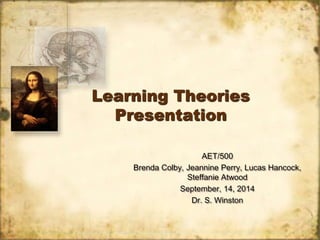
Learning theories presentation_week_6 final
- 1. Learning Theories Presentation AET/500 Brenda Colby, Jeannine Perry, Lucas Hancock, Steffanie Atwood September, 14, 2014 Dr. S. Winston
- 2. Learning Theories • Learning theories address how people learn. • Behavioral theories focus on the behavior of an individual, and what external stimuli causes them to learn. ̶ “All behavior can be explained without the need to consider internal mental states or consciousness” (Learning-Theories.com, 2014). • Cognitive theories focus on the innate ability of the individual to learn. ̶ “The learner is viewed as an information processor (like a computer)” (Learning-Theories.com, 2014).
- 3. Edward Thorndike - Behaviorist • Famous psychologist – recognized for his work on a learning theory on operant conditioning. • Operant conditioning defined as learning from the consequences of our behavior. • Three laws of learning. – The law of readiness - If a student is not prepared to learn it will not automatically happen. – The law of exercise – Practice increases efficiency and durability of learning . – The law of effect – reward and punishment.
- 4. Thorndike’s Law of Readiness • The law states that an organism (student) is only going to learn when they are physically and mentally ready to learn. • If a student is ready to learn, the act of learning will be satisfying. If the student is not able to learn when they are ready and willing, then they will become dissatisfied and annoyed. • Inversely, if a organism is not ready to learn, then being forced to work or learn will be dissatisfying and annoying.
- 5. Thorndike’s Law of Exercise • The law states that behaviors are more strongly established when there are frequent connections between stimulus and response. • This law was latter updated to because Thorndike discovered this was not true in all cases • The Law of Exercise was revised and also lead to a slight revision in Thorndike’s Law of Effect stating that positive reward significantly increases connections, but negative only slightly decreases them.
- 6. Thorndike’s Law of Effect • Thorndike designed and experiment called a puzzle box (see below) to test the laws of learning. • He put a cat in the puzzle box with a lever, if the cat hit the lever it would get a piece of fish. He would repeat this processes again and again and found that it took less time for the cat to hit the lever each time. • This brought him to the “Law of effect” which is defined as any behavior that is followed by pleasant consequences is likely to be repeated, and any behavior followed by unpleasant consequences is likely to be stopped.
- 7. Law of Effect and the Classroom • Satisfying conditions lead to unity and strengthening of the connection • If the response satisfies the student, then it is learned and accepted but if it is not satisfying, it is discarded. • The teaching, as a result, must be satisfying. • The more satisfied a student is with the learning process the stronger their motivation to learn.
- 8. Howard Gardner - Cognitivist • Psychologist inspired by Piaget. Studied neuropsychology and psycholinguistics. • Most known for his theory of Multiple Intelligences ̶ “Intelligence is the biopsychological potential to process information that can be activated in a cultural setting to solve problems or create products that are of value in a culture” (Garnder, 2000, p. 34). ̶ Learning can be achieved through other avenues then simple logical and linguistic thinking. ̶ Intelligence is a combination of 8 different modalities: not a simple, single ability
- 9. Gardner’s Multiple Intelligences (MI) • Eight different types of intelligence ̶ Musical-Rhythmic: sensitive to sounds, rhythms, tones, and music. ̶ Visual-Spatial: spatial judgment and the ability to visualize. ̶ Verbal-Linguistic: affinity for words and languages. ̶ Logical-Mathematical: logic, abstractions, reasoning, numbers, critical thinking. ̶ Bodily-Kinesthetic: control of one’s body movements, capacity to handle objects skillfully ̶ Interpersonal: interaction with others. ̶ Intrapersonal: introspective and self-reflective ability ̶ Naturalistic: ability to nurture and relate to one’s natural environment.
- 10. Applying theory to practice • Theory becomes more understandable when applied to practice. • E-Learning designs often include many of the multiple intelligence-based activities. • These activities are not especially unique. However, applying an MI perspective to activities ensures that learners have the chance to optimize their experience based on their individual MI strengths.
- 11. Applying theory to practice: Activities for each intelligence(Examples) Interpersonal Activities Established forums or online comminutes that support instruction enables the intrapersonal learner to share thoughts: •Online charts •Web conferencing •Email Intrapersonal Activities The Intrapersonal intelligence emphasizes the internal aspects of learning, self-esteem and “thinking about thinking •Providing positive feedback •Supplemental learning materials
- 12. Behavioral and Cognitive Learning Theories • Behavioral theories preceded cognitive. ̶ Learning is change in behavior, not the learner. ̶ Learners are passive participants. • Cognitive theories were in response to behavioral theories: learners are not programmed animals. ̶ Learners require active participation ̶ Information comes in, is processed, and results in desired outcome.
- 13. References Gardner, Howard (2000), Intelligence Reframed: Multiple Intelligences for the 21st Century, Basic Books, ISBN 978-0-465-02611-1 Learning Theories. (2014). Retrieved from www.learning-theories.com McLeod, S. (2007) Edward Thorndike; Simply Psychology Retrieved from http://www.simplypsychology.org/edward-thorndike.html Thorndike, E. L. (1898). Animal intelligence: An experimental study of the associative processes in animals. Psychological Monographs: General and Applied, 2(4), i-109.